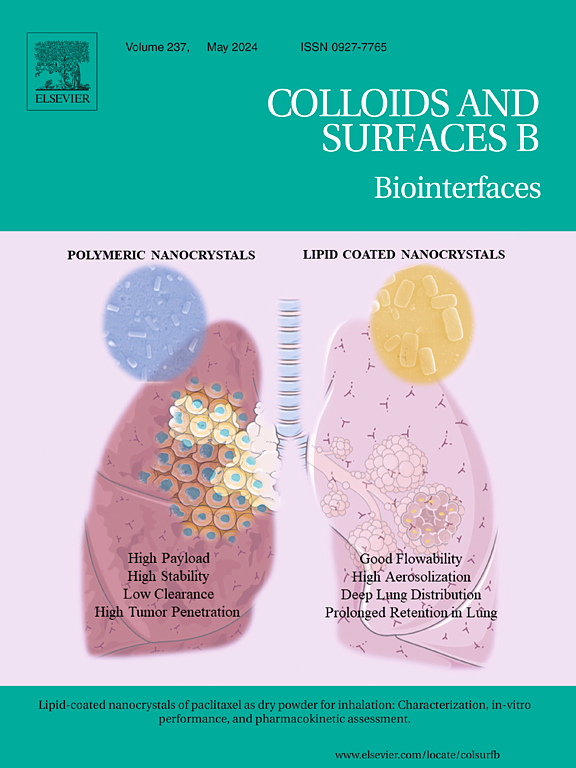Imitating the function of glucose oxidase by 3-aminopropyltriethoxysilane modified Cu2O for selective electrochemical glucose sensing
IF 5.4
2区 医学
Q1 BIOPHYSICS
引用次数: 0
Abstract
Selective detection of glucose in complex biological matrices remains a major challenge for non-enzymatic electrochemical sensors due to interference from co-existing species such as ascorbic acid (AA) and uric acid (UA). Herein, we developed an amine-functionalized Cu2O electrocatalyst (Cu2O-NH2), fabricated via a facile silanization strategy using 3-aminopropyltriethoxysilane (APTES) on Cu2O octahedron. The introduction of surface amine group effectively suppresses the interference signals of AA and UA by 34.78 % and 46.94 %, respectively, while boosting the glucose oxidation response by 1.8-fold compared with pristine Cu2O. The resulting Cu2O-NH2 sensor showed a wide linear range of 0.00089–1.27 mM with a high sensitivity of 1.6001 mA cm−2 mM−1, and a low detection limit of 0.89 μM, along with the excellent reproducibility and long-term stability. This customized Cu2O-NH2 material ultimately exhibited accurate measurement in actual human serum. Experimental studies and theoretical calculations reveal that the amine groups selectively inhibit the adsorption of AA and UA while accelerating the glucose oxidation kinetics, thus imitating the glucose oxidase-like function. Moreover, the universality of this APTES functionalization strategy was validated across other metal oxides, highlighting its potential to address the selectivity limitations of non-enzymatic sensors and offering new opportunities for the development of non-enzymatic biosensing platforms based on micro- and nano-structured materials.
3-氨基丙基三乙氧基硅烷修饰的Cu2O模拟葡萄糖氧化酶的功能,用于选择性电化学葡萄糖传感
由于抗坏血酸(AA)和尿酸(UA)等共存物质的干扰,非酶电化学传感器在复杂生物基质中选择性检测葡萄糖仍然是一个主要挑战。在此,我们开发了一种胺功能化的Cu2O电催化剂(Cu2O- nh2),该催化剂使用3-氨基丙基三乙氧基硅烷(APTES)在Cu2O八面体上通过易硅烷化策略制备。表面胺基的引入有效抑制了AA和UA的干扰信号,分别降低了34.78 %和46.94 %,同时提高了葡萄糖氧化响应,是原始Cu2O的1.8倍。该传感器线性范围为0.00089 ~ 1.27 mM,灵敏度为1.6001 mA cm−2 mM−1,检出限为0.89 μM,具有良好的重复性和长期稳定性。这种定制的Cu2O-NH2材料最终在实际的人血清中表现出精确的测量。实验研究和理论计算表明,氨基选择性抑制AA和UA的吸附,同时加速葡萄糖氧化动力学,从而模仿葡萄糖氧化酶样功能。此外,该APTES功能化策略的通用性在其他金属氧化物中得到了验证,突出了其解决非酶传感器选择性限制的潜力,并为基于微纳米结构材料的非酶生物传感平台的开发提供了新的机会。
本文章由计算机程序翻译,如有差异,请以英文原文为准。
求助全文
约1分钟内获得全文
求助全文
来源期刊

Colloids and Surfaces B: Biointerfaces
生物-材料科学:生物材料
CiteScore
11.10
自引率
3.40%
发文量
730
审稿时长
42 days
期刊介绍:
Colloids and Surfaces B: Biointerfaces is an international journal devoted to fundamental and applied research on colloid and interfacial phenomena in relation to systems of biological origin, having particular relevance to the medical, pharmaceutical, biotechnological, food and cosmetic fields.
Submissions that: (1) deal solely with biological phenomena and do not describe the physico-chemical or colloid-chemical background and/or mechanism of the phenomena, and (2) deal solely with colloid/interfacial phenomena and do not have appropriate biological content or relevance, are outside the scope of the journal and will not be considered for publication.
The journal publishes regular research papers, reviews, short communications and invited perspective articles, called BioInterface Perspectives. The BioInterface Perspective provide researchers the opportunity to review their own work, as well as provide insight into the work of others that inspired and influenced the author. Regular articles should have a maximum total length of 6,000 words. In addition, a (combined) maximum of 8 normal-sized figures and/or tables is allowed (so for instance 3 tables and 5 figures). For multiple-panel figures each set of two panels equates to one figure. Short communications should not exceed half of the above. It is required to give on the article cover page a short statistical summary of the article listing the total number of words and tables/figures.
 求助内容:
求助内容: 应助结果提醒方式:
应助结果提醒方式:


